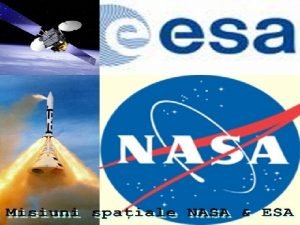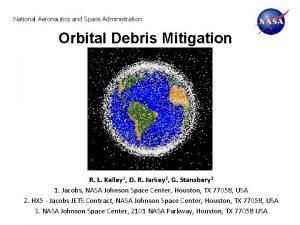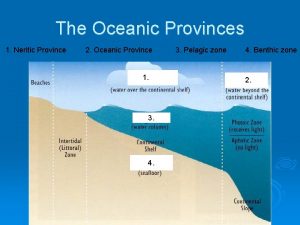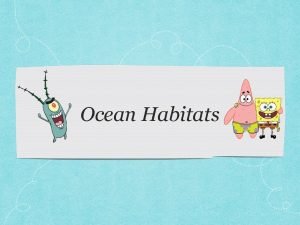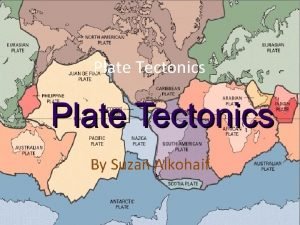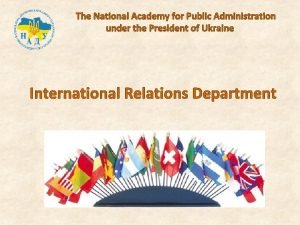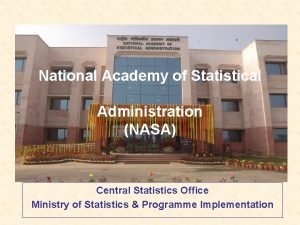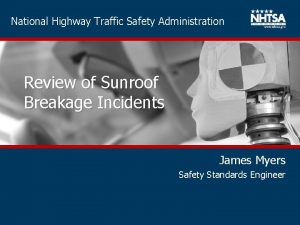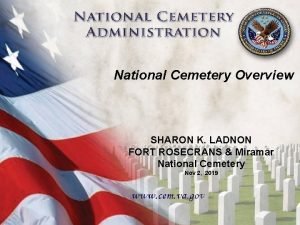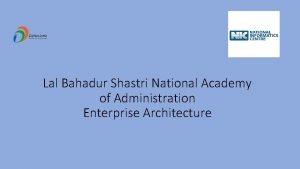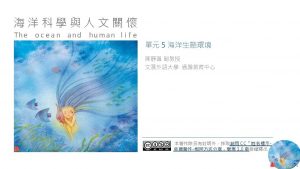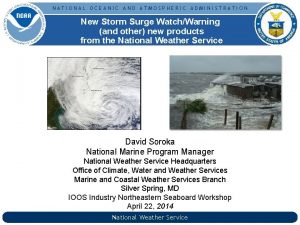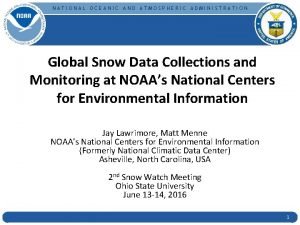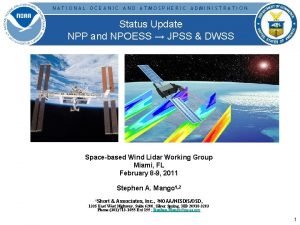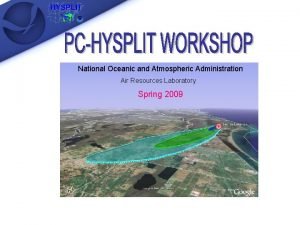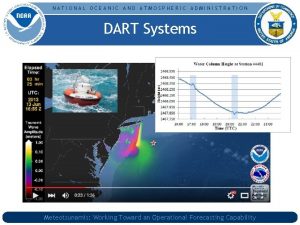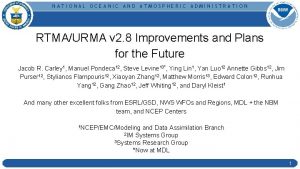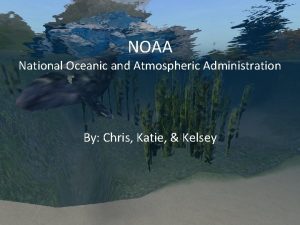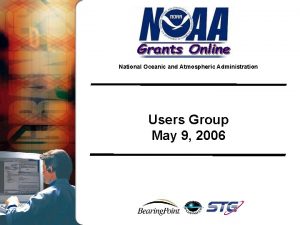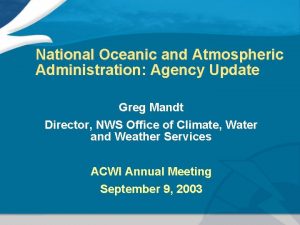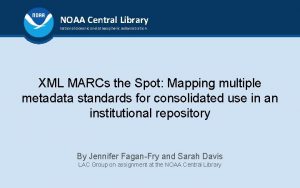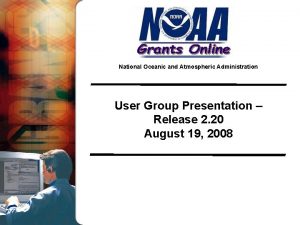NATIONAL OCEANIC AND ATMOSPHERIC ADMINISTRATION NOAAs Future Space















- Slides: 15

NATIONAL OCEANIC AND ATMOSPHERIC ADMINISTRATION NOAA’s Future Space Architecture: Assessing & Optimizing the Value of Observing Systems S. -A. Boukabara 1, R. N. Hoffman 2, D. Helms 1, N. Shahroudi 3, L. Cantrell 1, R. Montoro 4, S. Bunin 3, F. Gallagher 1, D. Spencer 1, G. Karbett 6, M. Mc. Hugh 4, E. Zimmerman 5 1 National Oceanic and Atmospheric Administration (NOAA) of Maryland (UMD) 3 Riverside Technology Inc. (RTI) 6 GOES-R 7 Former RTI 2 University February 24 th , 2020 NASA ESTO AIST/ESIP New Observing Strategies (NOS) Workshop 1

NATIONAL OCEANIC AND ATMOSPHERIC ADMINISTRATION Agenda § Context § Technology that NOAA Might Need in the Future – For Observing Systems – For Data Exploitation: Analytics § NOAA and NOS (ESTO/AIST New Observing Strategy NOS) § New Phase in NOAA’s Next-Gen Space Architecture – What is Needed? (from the Science/Analytics perspective) – ASPEN Concept Proposed § Conclusion February 24 th , 2020 NASA ESTO AIST/ESIP New Observing Strategies (NOS) Workshop

NATIONAL OCEANIC AND ATMOSPHERIC ADMINISTRATION NOAA Objectives for Future Observing Systems § Overall Objective (related to Designing Next-Gen Space Architecture) “As part of this new phase of the next-gen space architecture efforts, How do we go about optimizing the architecture? How do we maximize the benefit to our users, to our mission, to our applications? ” § Questions Being Asked / Items Being Considered: – Optimize how we are using satellite data now (in operations), – Answer questions in designing the next-gen architecture? (SW vs LW, Quantity versus Quality, etc) – Assess & prioritize which requirements take precedence over others – Undertake studies, or find mechanisms to actually optimize the constellations, based on sensors/constellations candidates – Assess scenarios, combinations, including international partnerships, commercial – Comparative assessments? How do we make sense of OSE, OSSE, FSOI, etc – How to find/select cost-effective solutions? – How do we interact with Industry? Or other Sensors-versed partners to optimize value and cost? February 24 th , 2020 NASA ESTO AIST/ESIP New Observing Strategies (NOS) Workshop

NATIONAL OCEANIC AND ATMOSPHERIC ADMINISTRATION Technologies that NOAA might Need Sensors/Constellation Technology § Atmospheric Wind profiling technology (lidar, etc) § Cost effective sensors (esp. Microwave and Infrared sounding but also scatterometers, DNB imagers, etc), i. e to be ported into smallsats, cubesats, etc but with equivalent or better performances to what we have now (with ATMS and Cr. IS for example in terms of radiometric noise, footprint size. . ) § Smallsats (small size, cubesat, etc) but with SI-traceable calibration technology § Higher/Ultra spectral sampling of Microwave spectrum, to increase information content and allow sounding of hydrometeors, surface parameters, lower atmospheric boundary conditions, etc § Technology Capability to mitigate or eliminate RFI impacts in Microwave sensors § Sensing technology enhancement leading to higher spatial, temporal and spectral and/or radiometric performances/resolutions § Submillimeter frequencies and higher frequency polarimetric measurements, for ice, snow § Technology for payload-hosting Earth observations sensors on existing commercial satellite platforms (leveraging) or on new innovative platforms (such as near-space based platforms such as stratospheric Balloons) February 24 th , 2020 NASA ESTO AIST/ESIP New Observing Strategies (NOS) Workshop

NATIONAL OCEANIC AND ATMOSPHERIC ADMINISTRATION Technologies that NOAA might Need Analytics Technology § Efficient Data Fusion from Multiple Sources § AI enabled technology to extract novel information and infuse efficiency § Exploiting New/innovative sources of Environmental Data (Io. T) § Resolution Enhancement § Quantification of Output Uncertainty § Assess (and then optimize) value, benefits, and positive impacts of observations on a range of applications § Trend toward Earth System Prediction (ESP) to converge applications, with impact on Observations use § Approaches to rapidly exploit Sensors webs § Calibration methodologies in an era of cubesats, smallsats, etc § Automatic monitoring, anomaly detection, correction § Detecting & Correcting RFI impacts February 24 th , 2020 NASA ESTO AIST/ESIP New Observing Strategies (NOS) Workshop

NATIONAL OCEANIC AND ATMOSPHERIC ADMINISTRATION NOAA and NOS Benefits (Linkages and Leveraging Potential) NOAA Technology Emergence (Industry, Academia, etc) Technology Innovation & Research STAR: - Science support - Develop algorithms - Observation Exploitation - Sensors design - Optimize constellation - etc NESDIS/ OPAA Technology Maturation NESDIS/ OSAAP Pre-Formulation NESDIS LEO, GEO (programs) February 24 th , 2020 Next-Generation Space Architecture Last Phases: (Formulation, Implementation & Deployment) NASA ESTO AIST/ESIP New Observing Strategies (NOS) Workshop NASA/ ESTO e. g. NASA/GSFC NOS: - Exploit newly available observational capabilities - Development information technologies - Support planning, evaluating, implementing, and operating dynamic, multi-element sets of observing assets 6

NATIONAL OCEANIC AND ATMOSPHERIC ADMINISTRATION What is Needed? (from the Science/Analytics perspective. Why and What Are we trying to do? ) Ø Risk Assessment & Full Awareness of Impacts Ø What is the impact of the decision we make on users? Ø What gaps (in observables) are we tolerating? Ø What Potential capability Overlaps are there? Ø Decision-Making Support Tool Ø Space Architecture decisions (GEO-XO, LEO, etc) Ø Commercial Data Buys values/criteria Ø Data Partnership Value assessment Ø Etc February 24 th , 2020 NASA ESTO AIST/ESIP New Observing Strategies (NOS) Workshop 7

NATIONAL OCEANIC AND ATMOSPHERIC ADMINISTRATION ASPEN Concept (Advanced Systems Performance Assessment tool for NOAA) Sensor Candidate 1 Environment Va to lue A 1 of S 2 Observables (Requirements) Value of S 1 to A 1 Application 1 Sensor Candidatee 2 of S 2 f S 1 eo u l Va o A 2 t Application 2 (Requirements) u Val o A 2 t February 24 th , 2020 NASA ESTO AIST/ESIP New Observing Strategies (NOS) Workshop 8

NATIONAL OCEANIC AND ATMOSPHERIC ADMINISTRATION Proposed Approach Users & SPRWG Independent Information Requirements Ranges Current and Future [by application] Technical Users Representatives (& TPIO) Industry Partners (NASA, Aerospace, etc. ) & STAR ADRR Derived Information GCA Geophysical Capabilities Assessment [by application, by sensor/constellation] Sensor/Constellation Performances [by sensor/constellation] SCBP Technical Priorities Assessment [by application] Application-Dependent Benefit to NOAA [by application, by sensor/constellation] Strategic Users Representatives ADTP Domain-Dependent Priorities Assessment [by application, by domain] Domain-Specific Benefit to NOAA [by domain] Strategic Users Representatives WDRP Strategic Priorities Assessment Overall Benefit to NOAA [1 for all domains] [by sensor/constellation] Account for costs… OSP February 24 th , 2020 NASA ESTO AIST/ESIP New Observing Strategies (NOS) Workshop 9

NATIONAL OCEANIC AND ATMOSPHERIC ADMINISTRATION Strategically Important Factors (When designing, optimizing, or assessing Value of Space Architecture Assets) Ø Transparency (of decision-making) Ø Traceability to impact on users Ø Accounting for technical/strategic users perspectives Ø Comparative assessment vs Individual assessment (accounting for cost and performance) Ø Finding an optimal (cost-effective) constellation (demonstratable) Ø Wide buy-in from users & community (for the next-gen architecture) Ø Defendable approach (with stakeholders) February 24 th , 2020 NASA ESTO AIST/ESIP New Observing Strategies (NOS) Workshop 10

NATIONAL OCEANIC AND ATMOSPHERIC ADMINISTRATION Technically Important Factors Ø Comprehensiveness (to all applications, etc. ) Ø Quick turnaround for results Ø Dynamically adaptable to work with industry and flexible enough to perform “what if” scenarios Ø Added Uncertainty to overall values, to assess impact of assumptions February 24 th , 2020 NASA ESTO AIST/ESIP New Observing Strategies (NOS) Workshop 11

NATIONAL OCEANIC AND ATMOSPHERIC ADMINISTRATION Role and Scope of SAT (Systems performance Assessment Team) Assess Value of Commercial Data Highlight Science Tasks Assess Value and Impact on Applications Systems and Sensor Performance Assessment SAT Build on / Traceability to NSOSA (SPRWG) Core. SAT Answer Scientific Questions to Help Design Strategic & Programmatic (recommendations on cost, optimal designs) Support Review/Feedback to White Papers, Proposals, etc. Setting, reviewing, updating Requirements, GEO IPT § Sounder, imager, space weather sensor, lightning, MW & IR Assess Current and Future Uses, Needs/Feedback LEO IPT § Sounder satellite (IR, MW, RO) § Wind Lidar § OSVW § MW/IR imager § Etc Ground Processing IPT Coordinate Science Aspect with NASA, DOD, Industry Partners February 24 th , 2020 NASA ESTO AIST/ESIP New Observing Strategies (NOS) Workshop 12

NATIONAL OCEANIC AND ATMOSPHERIC ADMINISTRATION BACKUP February 24 th , 2020 NASA ESTO AIST/ESIP New Observing Strategies (NOS) Workshop 13

NATIONAL OCEANIC AND ATMOSPHERIC ADMINISTRATION SAT Timeline/Work Plan Nov Dec Feb Mar Apr B 10: Assessing potential of rideshares for LEO B 7: Assessment of precipitation radar B 6: Ocean Surface Wind Vector strategic B 2: SW vs LW recommendation assessment B 3: Study 50 vs 118 GHz for MW temp B 1: Addition of limited imager to sounder satellite soundings B 4: 3 D winds strategic assessment B 8: Approach to space weather B 5: Wind lidar technology tracking B 9: Value of VIIRS-type imagery C 1: Prioritization of metrics for optimization of space architecture C 4: Comparative Value Assessment Tool C 5: Process to optimize observation/sensor selection for LEO C 3: Study update rate vs spatial resolution for NWP C 2: Global vs regional data collection D 6: Assessment of International Partner Plans D: Awareness Activities D 1: NWP model evolution D 2: Compilation of existing impact assessment activities D 4: Assessment of Do. D Next-Gen space architecture D 5: Assessment of NASA’s space plans D 7: WMO WIGOS 2040 vision E 2: Hypothetical obs improvements – Regional soundings F: Science. Linked Strategy E: Assessment of Impact of Obs on Applications Jan A 3: Support BAAs for other missions A 3: Review BAA papers: GEO-XO A 3: Review BAA papers: Sounder. SAT A 4: Extend requirements to other observables C: Constellation Supporting Science B: LEO/GEO Sensors/ Satellite Support A: Science Requireme nts and BAA Support Oct February 24 th , 2020 E 1: Hypothetical obs improvements – OSVW E 3: Hypothetical obs improvements – Chemical, aerosols, etc E 4: Value of data continuity to NOAA priorities E 6: Assessment of sounder data E 5: Assessment of wind lidar E 8: Assessment of extended sounder vs hyperspectral IR E 7: Assessment of 2 sounders on GEO (MW & IR on GEO hyperspectral) F 1: Long-term commitment to geomagnetic storm forecasting F 2: Obs related to medium range NWP improvements F 3: Exploring observation performance trades NASA ESTO AIST/ESIP New Observing Strategies (NOS) Workshop

NATIONAL OCEANIC AND ATMOSPHERIC ADMINISTRATION February 24 th , 2020 NASA ESTO AIST/ESIP New Observing Strategies (NOS) Workshop 15
 Ocean to ocean convergent boundary
Ocean to ocean convergent boundary Oceanic oceanic convergent boundaries
Oceanic oceanic convergent boundaries National aeronautics and space administration
National aeronautics and space administration Debris assessment software
Debris assessment software Future perfect or future continuous
Future perfect or future continuous Future perfect simple continuous
Future perfect simple continuous Mesopelagic zone
Mesopelagic zone Intertidal zone neritic zone and oceanic zone
Intertidal zone neritic zone and oceanic zone Convergent plate boundary
Convergent plate boundary Continental and oceanic crust
Continental and oceanic crust National academy for public administration
National academy for public administration National academy of statistical administration
National academy of statistical administration National highway safety administration reviews
National highway safety administration reviews Tahoma national cemetery grave locator
Tahoma national cemetery grave locator Lbsnaa mess menu
Lbsnaa mess menu Future continuous.
Future continuous.


